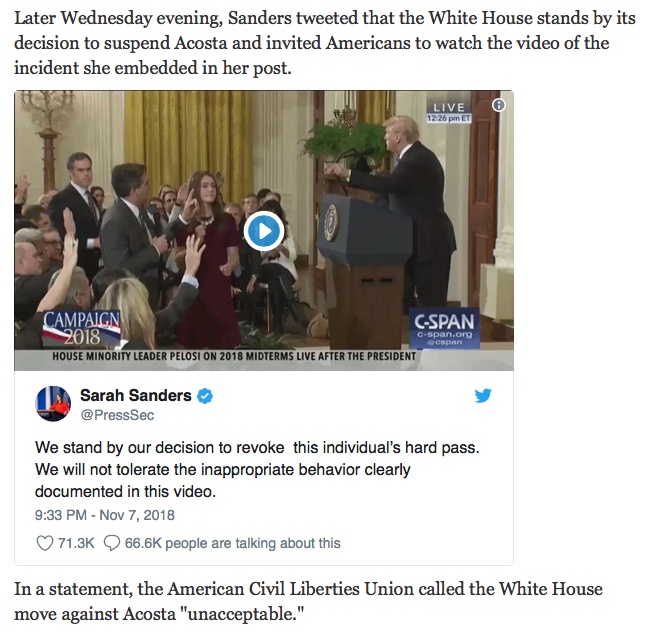Needless to say, the folks at the Jim Acosta-hating Media Research Center couldn’t have been happier that the White House suspended Acosta’s “hard pass” for White House access, and that also goes for the MRC’s “news” division, CNSNews.com. A Nov. 7 blog post by Craig Bannister cheered Acosta’s pass suspension, adding that White House press secretary Sarah Huckabee Sanders “tweeted that the White House stands by its decision to suspend Acosta and invited Americans to watch the video of the incident she embedded in her post,” and embedding the Sanders tweet containing the video in his post.
Just one problem: the video was doctored. A video expert enlisted by the Associated Press documented how the video tweeted out by Sanders had frames sped up to make Acosta’s action in trying to keep a White House intern from taking the microphone from him while he was asking President Trump a question look more aggressive than it was in reality, while other frames were slowed down to make the video’s run time the same as an unaltered video. The doctored video apparently came from a reporter for far-right conspiracy site Infowars. Heck, even one of CNS’ favorite conservatives, Ben Shapiro, called out Sanders for sending out a doctored video.
Despite all that, Bannister’s post was never updated to reflect the controversy over the video.
Two days later, an article by Melanie Arter addressed the issue not by admitting the clear, unambiguous evidence that the video was doctored, but by starting out in stenography mode, giving Trump three paragraphs to falsely rant that the video wasn’t doctored:
President Donald Trump called out the media for reporting that a video that White House Press Secretary Sarah Huckabee Sanders released of a White House intern trying to take the microphone away from CNN’s Jim Acosta at Monday’s White House press conference was doctored.
When asked why Sanders “shared a doctored video of the incident in the East Room,” Trump said, “The taped video of Acosta? What are you talking about? Nobody manipulated it. Give me a break. See that’s just dishonest reporting. All that is is a close-up.”
“They showed it close-up, and he was not nice to that young woman. I don’t hold him for that, because it wasn’t overly, you know, horrible, but all that was– When you say doctor, you’re a dishonest guy, because it wasn’t doctored. They gave a close-up view. That’s not doctoring,” the president said.
Even though the facts are not on Trump’s side, Arter chose instead to present the story as a he said-she said, following Trump’s rant with a statement that “The Washington Post reported Thursday that Sanders shared a video ‘that appeared to have been altered’ to make Acosta’s actions ‘ook more aggressive toward a White House intern,'” with two additional paragraphs from the Post article.
Giving falsehoods the same credulity as the truth without admitting that the falsehoods are, in fact, false is the very definition of false balance. That’s what you do when you’re a stenographer and not a reporter.
Arter concluded her article with some uncritical dissembling from Sanders on the doctored video:
After the media questioned the reasoning behind the White House’s decision, Sanders issued a statement Thursday addressing reports that the video she shared was doctored.
“The question is: did the reporter make contact or not? The video is clear, he did. We stand by our statement,” she said.
Arter did not mention that the question was actually about the doctored video, nor did she point out that Sanders refused to answer the question that was asked. She’s a stenographer, after all.
